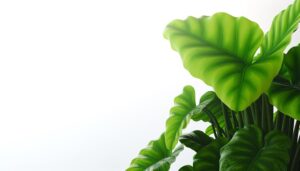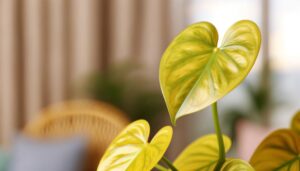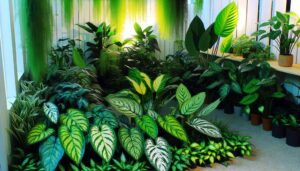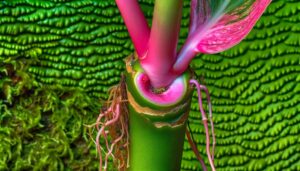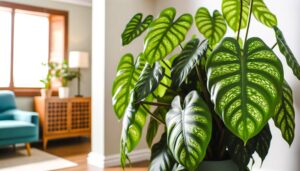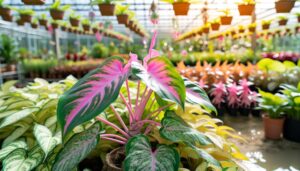What Are the Different Varieties of Philodendron Brasil?
Philodendron Brasil, known for its vibrant variegated foliage, has several remarkable varieties. The Classic Philodendron Brasil showcases heart-shaped leaves with a central lime green stripe.
The Variegated Philodendron Brasil exhibits intricate chlorophyllous and non-chlorophyllous patterns. Philodendron Rio is distinguished by creamy-white stripes due to a chimeric mutation.
The Philodendron Cream Splash features pale streaks on intricate variegation. Finally, Philodendron Silver Stripe is known for elongated leaves with silver and white streaks.
Each variety thrives in well-draining soil and indirect light, offering unique aesthetic appeal and growth habits. Explore further to understand their specific care requirements.
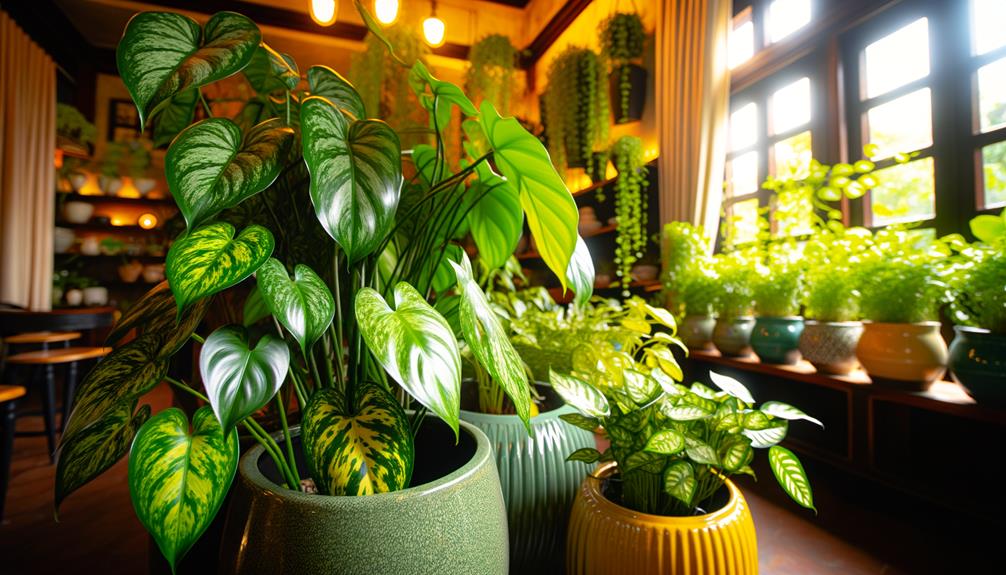
Key Takeaways
- Classic Philodendron Brasil has heart-shaped leaves with lime green central stripes and dark green margins.
- Variegated Philodendron Brasil features a complex mosaic of yellow and green hues.
- Philodendron Rio showcases creamy-white stripes with silvery-grey, cream, and green variegation.
- Philodendron Cream Splash has intricate variegations with green, pale, and yellow hues.
- Philodendron Silver Stripe displays elongated leaves with silver and white streaks along the margins and midrib.
Classic Philodendron Brasil
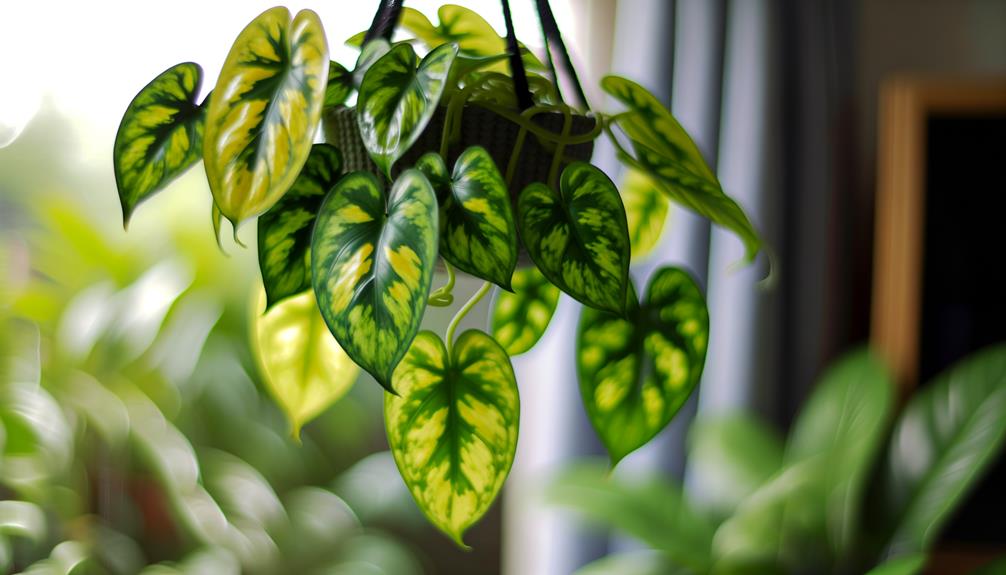
The Classic Philodendron Brasil, scientifically known as Philodendron hederaceum 'Brasil,' is characterized by its distinctive heart-shaped leaves with variegated patterns of green and yellow.
This cultivar exhibits a robust climbing habit, making it suitable for both hanging baskets and trellises. The foliage displays a central stripe of lime green, bordered by darker green margins, resulting from chimeric variegation. Its aerial roots facilitate efficient anchorage and nutrient absorption, enabling the plant to thrive in diverse environments.
Best growth is achieved under indirect light and well-draining, organic-rich soil. The Philodendron hederaceum 'Brasil' is renowned for its adaptability and low maintenance, making it a preferred choice among horticulturists and plant enthusiasts seeking both aesthetic appeal and ease of care.
Variegated Philodendron Brasil
The Variegated Philodendron Brasil (Philodendron hederaceum 'Brasil') displays a complex mosaic of chlorophyllous and non-chlorophyllous sectors on its foliage, creating a striking visual contrast.
This cultivar requires specific light conditions, preferably bright, indirect light, to preserve its variegation, and needs a balanced watering schedule to avoid root rot.
Successful growth and care depend on grasping its unique physiological needs, including ideal humidity and nutrient requirements.
Unique Leaf Patterns
Philodendron hederaceum 'Brasil' exhibits a remarkable array of variegated leaf patterns characterized by vivid yellow and green hues. The foliage showcases a striking combination of bright, lime-green centers bordered by deep emerald green margins. These variegations are a result of chlorophyll distribution variations within the leaf tissues.
Some leaves may display asymmetrical variegation, with irregular splashes and streaks of yellow intermixed with green. Juvenile leaves of P. hederaceum 'Brasil' generally present more pronounced variegation compared to mature leaves. This heterogeneity in leaf patterns contributes to the plant's ornamental value and visual appeal.
The genetic basis for these variegations involves mutations in the chloroplast DNA, resulting in chimeric tissues that express both green and yellow pigmentation.
Light and Water Needs
Understanding the light and water requirements of Philodendron hederaceum 'Brasil' is crucial for maintaining its vibrant variegation and overall health. This variegated cultivar thrives best in bright, indirect light. Exposure to excessive direct sunlight can cause leaf burn, while insufficient light leads to diminished variegation and slower growth. Ideal lighting conditions ensure the retention of the distinct yellow and green coloration.
Regarding hydration, Philodendron hederaceum 'Brasil' prefers moderately moist soil. Overwatering can lead to root rot, a common issue in poorly drained substrates. Conversely, prolonged dryness may cause leaf curling and browning.
Using a well-aerated, well-draining potting mix and allowing the top inch of soil to dry between waterings can minimize these risks, promoting a healthy, thriving specimen.
Growth and Maintenance
Effective growth and maintenance of Philodendron hederaceum 'Brasil' involve regular pruning, routine feeding, and monitoring for pests and diseases to guarantee its vigorous development and aesthetic appeal.
Pruning promotes bushier growth and removes yellowing or damaged leaves, maintaining the plant's variegation. Nutrient-rich, well-draining soil is essential, with applications of balanced, water-soluble fertilizer every 4-6 weeks during the growing season.
Monitoring for common pests like aphids, spider mites, and mealybugs, along with fungal infections, is essential. Implementing integrated pest management (IPM) strategies, such as neem oil treatments and maintaining proper humidity, can mitigate these issues.
Regularly wiping leaves with a damp cloth prevents dust accumulation and enhances photosynthesis efficiency, ensuring the plant's overall robustness.
Philodendron Rio
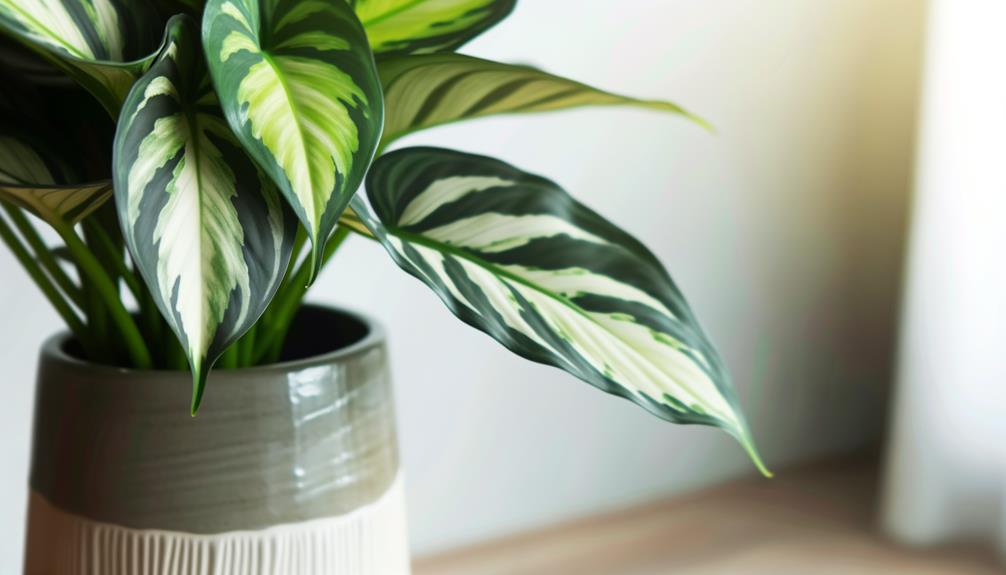
Philodendron hederaceum 'Rio' is recognized for its striking variegation, featuring a central creamy-white stripe flanked by shades of green on each leaf.
This cultivar necessitates specific care, including well-draining soil and consistent humidity levels, to maintain its vibrant foliage.
Proper light conditions, avoiding direct sunlight, are essential for the preservation of its distinctive leaf patterns.
Distinctive Leaf Patterns
One of the most remarkable features of Philodendron hederaceum var. oxycardium 'Rio' lies in its distinctive leaf variegation, displaying a complex interplay of silvery-grey, cream, and green hues.
The leaves are cordate, with a pointed apex, and can reach lengths of up to 15 cm. The variegation pattern typically shows a central stripe of silvery-grey flanked by irregular bands of cream and dark green, creating a visually enthralling mosaic.
This intricate pattern is a result of chimeric mutation, wherein different cell layers express distinct pigments. The contrasting colors are not only aesthetically pleasing but also indicative of the plant's health and importance, making Rio a highly sought-after cultivar among philodendron enthusiasts.
Care and Maintenance
Maintaining the health of Philodendron hederaceum var. oxycardium 'Rio' requires a balanced approach to light, water, and humidity to emulate its native tropical environment. Ideal lighting conditions involve bright, indirect light; direct sunlight may cause photodamage to its variegated leaves.
Watering should be consistent yet moderate, ensuring the substrate remains moist but not waterlogged to prevent root rot. Employing a well-draining potting mix, enriched with organic matter, can enhance soil aeration and moisture retention.
Humidity levels should ideally range between 60-80%, mimicking tropical conditions. Regular misting or utilizing a humidifier can help maintain these levels. Additionally, periodic pruning encourages vigorous growth and maintains aesthetic appeal.
Fertilization with a balanced, water-soluble fertilizer during the growing season supports peak health.
Philodendron Cream Splash
Characterized by its eye-catching variegation and distinctive pale streaks, Philodendron hederaceum 'Cream Splash' is a unique cultivar within the Araceae family. This cultivar exhibits an intricate pattern of variegation, featuring a harmonious blend of green, pale, and yellow hues. The leaves are typically heart-shaped, displaying a velvety texture that adds to its ornamental appeal.
'Cream Splash' thrives in indirect light, where its variegation is most pronounced. It prefers a well-draining potting mix rich in organic matter, maintaining moderate moisture levels. Best growth conditions include humidity levels above 60% and temperatures ranging between 18-24°C.
Propagation is commonly achieved through stem cuttings, ensuring genetic consistency. Its attractive appearance makes it a favored choice among indoor plant enthusiasts.
Philodendron Silver Stripe
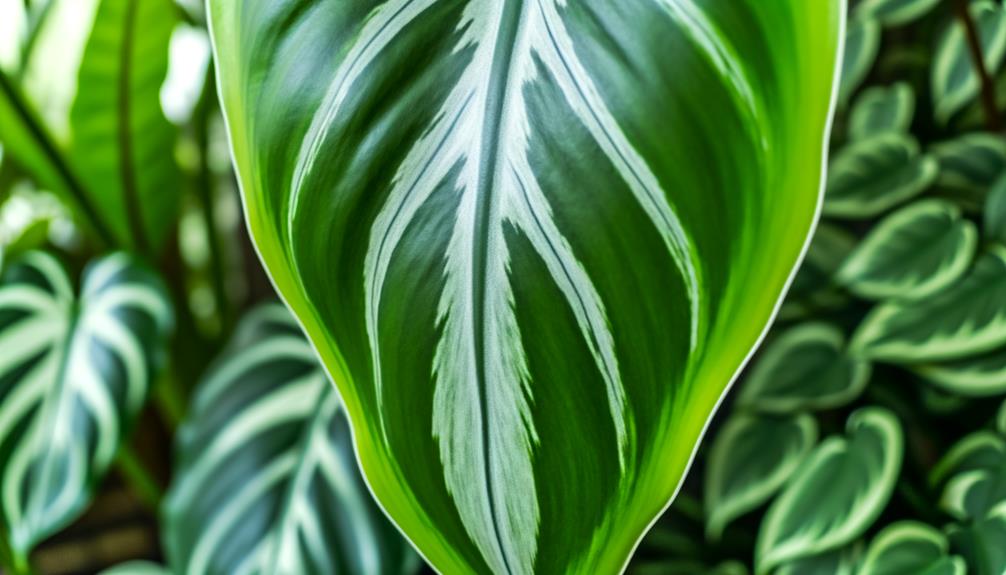
In addition to the 'Cream Splash', the Philodendron hederaceum 'Silver Stripe' offers another striking example of variegation within the Araceae family, distinguished by its elongated, heart-shaped leaves adorned with silver and white streaks.
These variegations are irregular, with the silvery hues often appearing along the leaf margins and midrib, providing a stark contrast to the lush green background. This cultivar thrives in well-draining soil with moderate humidity, simulating its native tropical environment.
Optimal growth occurs under indirect light, which enhances the variegation patterns. The 'Silver Stripe' is a climbing epiphyte, making it ideal for hanging baskets or climbing supports.
Regular pruning encourages denser foliage, enhancing its ornamental appeal.
Philodendron Gabby
Why is the Philodendron hederaceum 'Gabby' so alluring to botanists and plant enthusiasts alike?
The charm lies in its unique variegation patterns, where creamy white and light green hues blend seamlessly with darker green foliage. This variegation is not merely aesthetic but indicative of genetic mutations that fascinate botanists.
Philodendron hederaceum 'Gabby' thrives in indirect light, which helps maintain its variegated appearance. The leaves are heart-shaped, with a glossy texture that reflects light, enhancing its visual appeal.
Additionally, 'Gabby' exhibits a vining growth habit, making it suitable for hanging baskets or climbing structures. Understanding its specific care requirements, including moderate watering and well-draining soil, is essential for its cultivation and propagation, drawing plant enthusiasts into deeper botanical exploration.
Philodendron Lemon Lime
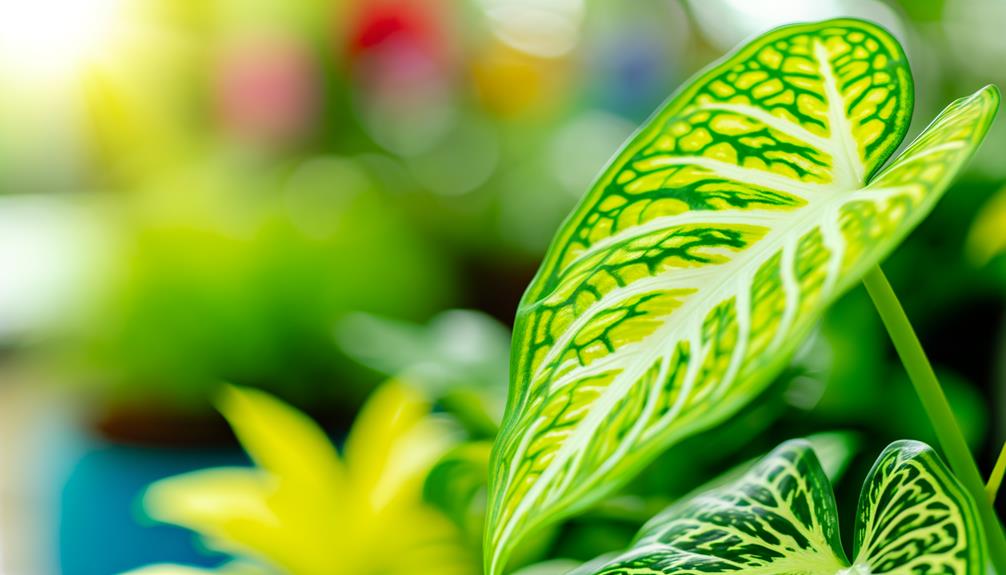
Philodendron hederaceum 'Lemon Lime' is distinguished by its vibrant chartreuse foliage, which provides an eye-catching contrast to the darker green leaves commonly found in other varieties.
Best care includes maintaining moderate humidity levels, indirect sunlight, and well-drained soil to promote healthy growth.
Propagation is typically achieved through stem cuttings, which root readily under suitable conditions, ensuring vigorous proliferation.
Bright Foliage Characteristics
Characterized by its vibrant, chartreuse foliage, Philodendron hederaceum 'Lemon Lime' displays strikingly bright leaves that greatly enhance its ornamental appeal. This variety is distinguished by its unique leaf pigmentation, which is a vivid yellow-green, making it a standout among indoor plants. The leaf morphology is typically heart-shaped with a smooth, glossy texture. The chlorophyll concentration within the leaves contributes to their luminescent quality, which is both eye-catching and indicative of its healthy state.
| Feature | Description | Scientific Term |
|---|---|---|
| Foliage Color | Chartreuse | Chlorophyll-rich |
| Leaf Shape | Heart-shaped | Cordate |
| Texture | Smooth, glossy | Glabrous |
| Growth Habit | Trailing, vining | Scandent |
| Light Reflection | High | Reflectance capacity |
This variety's distinctive attributes make it a popular choice for enhancing indoor environments.
Care and Maintenance
Proper care and maintenance of Philodendron hederaceum 'Lemon Lime' involve providing ideal lighting, consistent watering, and appropriate humidity levels to ensure robust growth and vibrant foliage.
Excellent lighting conditions include bright, indirect sunlight to prevent chlorophyll degradation while promoting photosynthesis.
Watering should be moderate; allow the top inch of the substrate to dry before rehydrating, thereby preventing root rot (Pythium spp).
Philodendron hederaceum thrives in humidity levels ranging from 60-80%, mimicking its native tropical environment.
Employing a peat-based potting mix with high organic content supports sufficient nutrient uptake and aeration.
Regularly inspect for common pests such as aphids (Aphidoidea) and spider mites (Tetranychidae), and utilize appropriate biological controls or insecticidal soaps as necessary.
Growth and Propagation
Encouraging the growth and propagation of Philodendron hederaceum 'Lemon Lime' requires a thorough understanding of its asexual reproduction methods, primarily stem cuttings, and the best environmental conditions to foster root development and overall plant vigor.
Stem cuttings should include at least one node and a few leaves. Place the cuttings in water or a well-draining potting mix rich in organic matter. Best temperature ranges between 18-24°C (65-75°F) with high humidity levels (60-80%).
Adequate indirect light is essential to avoid leaf scorching while promoting photosynthesis. Regular misting and maintaining soil moisture without waterlogging are necessary. Root development typically occurs within 2-4 weeks, signaling successful propagation.
Philodendron Golden Goddess
The Philodendron 'Golden Goddess' (Philodendron 'Malay Gold') is distinguished by its vibrant, chartreuse foliage that thrives in well-lit indoor environments. This cultivar exhibits striking, elongated leaves that can reach lengths of 20-30 cm.
The leaves' bright yellow-green hue is a result of chlorophyll concentration, which is ideal under indirect sunlight. The 'Golden Goddess' requires a well-draining potting mix and consistent moisture levels to prevent root rot. Best growth conditions include temperatures between 18-24°C and relative humidity above 60%.
This variety is a non-climbing philodendron, making it suitable for container growth. Fertilization with balanced, water-soluble nutrients every 4-6 weeks supports its lush appearance and vigorous growth. Regular pruning helps maintain its compact, bushy form.
Philodendron Neon
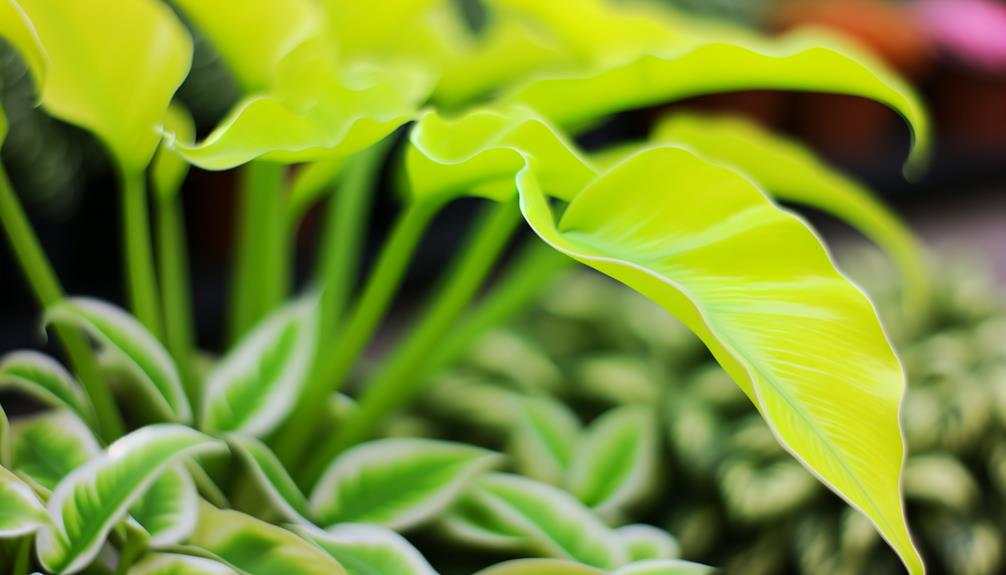
Philodendron Neon, known for its vivid lime-green foliage, is a visually striking cultivar that thrives in well-lit, humid environments.
Botanically classified as Philodendron hederaceum 'Neon', this variety is characterized by heart-shaped leaves that possess a striking, almost fluorescent green color, enhancing its ornamental appeal.
Best growth occurs in indirect sunlight and high humidity, which mimics its native tropical habitat.
The Neon Philodendron's leaves can reach up to 30 cm in length, offering a lush, verdant aesthetic.
This cultivar prefers well-draining soil with a balanced pH and benefits from regular misting to maintain humidity levels.
It is also notable for its air-purifying qualities, making it a valuable addition to indoor plant collections.
Philodendron Moonlight
Characterized by its vibrant chartreuse foliage, Philodendron 'Moonlight' (Philodendron hederaceum 'Moonlight') is a hybrid cultivar that thrives in bright, indirect light and high humidity.
This aroid plant features lanceolate leaves that exhibit a strikingly luminous, almost neon yellow-green hue, which shifts to a deeper green as they mature. Morphologically, the petioles are sturdy and the leaves have a smooth texture, indicative of its hybrid vigor.
Philodendron 'Moonlight' is known for its compact growth habit, making it an ideal specimen for indoor cultivation. The plant's robust root system and high tolerance for varied substrate pH levels contribute to its adaptability, while its aerial roots facilitate nutrient and moisture absorption.
This variety is a prime example of cultivar innovation within the Araceae family.
Care Tips for Varieties
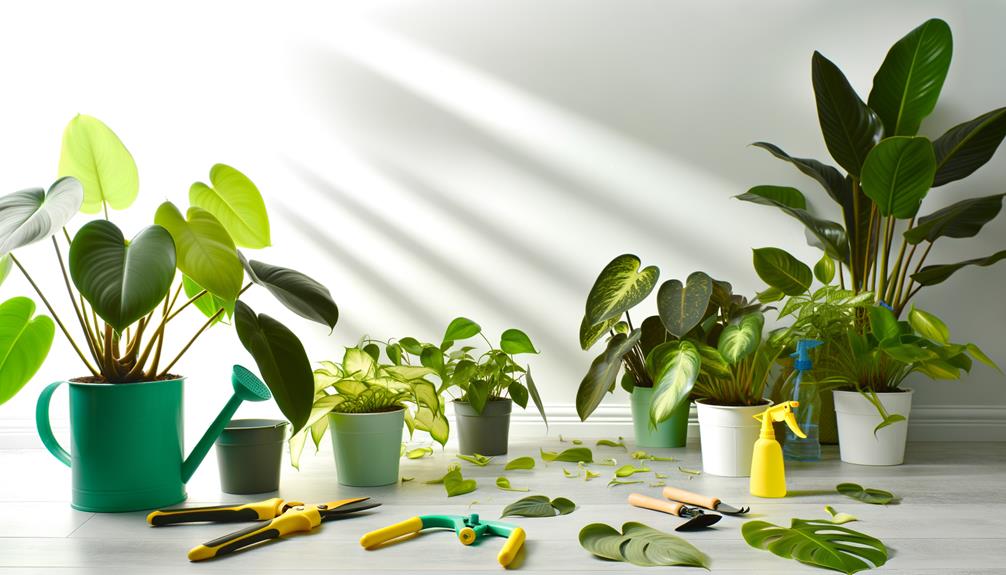
Understanding the specific care requirements for different Philodendron varieties, such as the 'Moonlight', is fundamental to guaranteeing their best growth and health. Philodendron hederaceum 'Brasil' thrives in indirect light and requires well-draining soil to prevent root rot. Regular watering is essential, allowing the top inch of soil to dry out between waterings. Humidity levels of 60-80% are ideal for peak growth. Fertilize monthly during the growing season with a balanced liquid fertilizer.
| Care Aspect | Details | Importance |
|---|---|---|
| Light | Indirect, bright light | Prevents leaf burn and promotes growth |
| Watering | Allow top inch to dry | Prevents root rot |
| Soil | Well-draining, rich in organic matter | Ensures proper aeration |
| Humidity | 60-80% | Enhances vigor and prevents leaf browning |
| Fertilization | Monthly during growing season | Supports robust growth |
Attentive focus on these requirements will result in vibrant and healthy plants.
Conclusion
The diversity within Philodendron hederaceum cultivars includes the Classic Philodendron Brasil, Variegated Philodendron Brasil, Philodendron Rio, Philodendron Cream Splash, Philodendron Silver Stripe, Philodendron Golden Goddess, Philodendron Neon, and Philodendron Moonlight. These cultivars showcase a wide array of foliage patterns and colors, each exhibiting unique variegation and pigmentation due to genetic variations.
Proper care is essential for these plants, including providing ideal light, humidity, and soil conditions to ensure robust growth and vibrant foliage. Understanding these specific requirements is crucial to maintaining the aesthetic and health of these ornamental plants.

